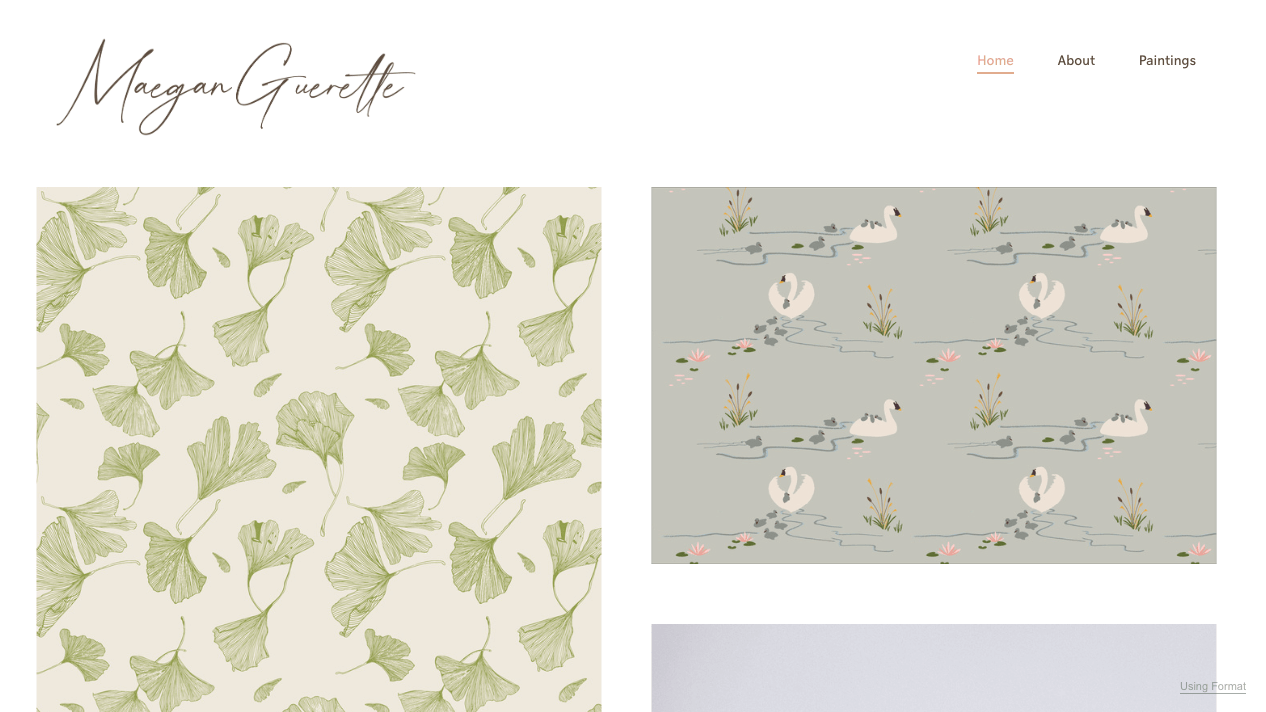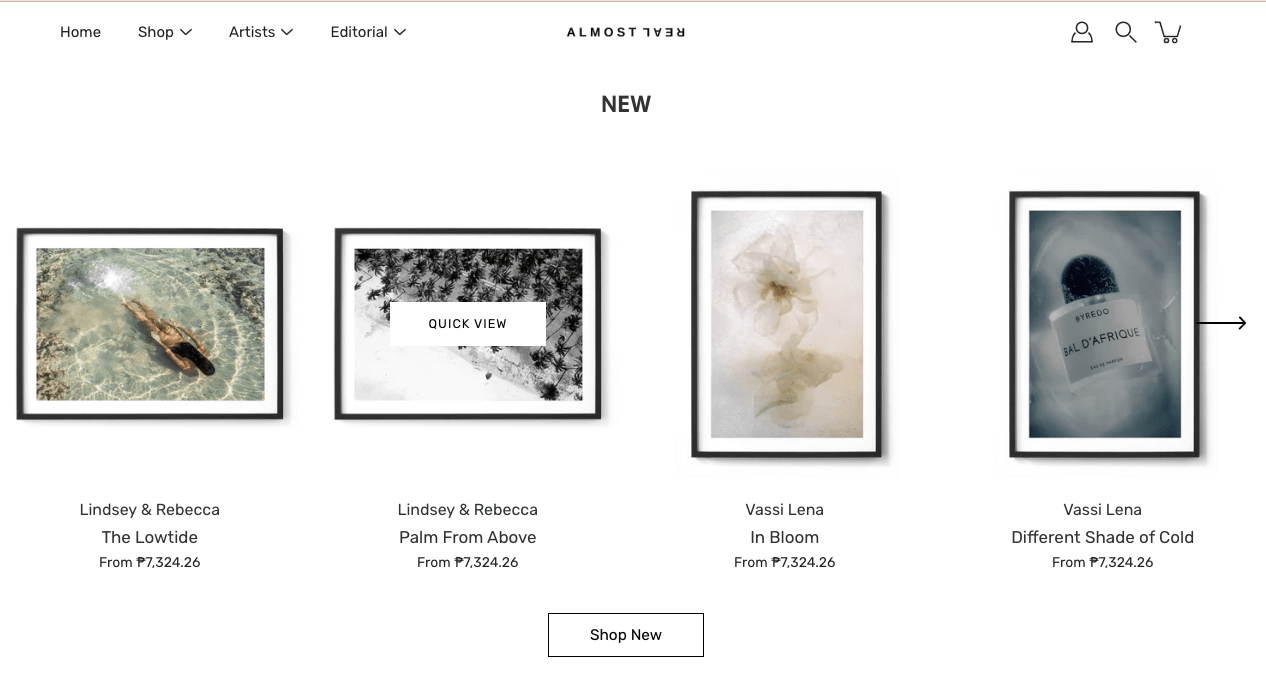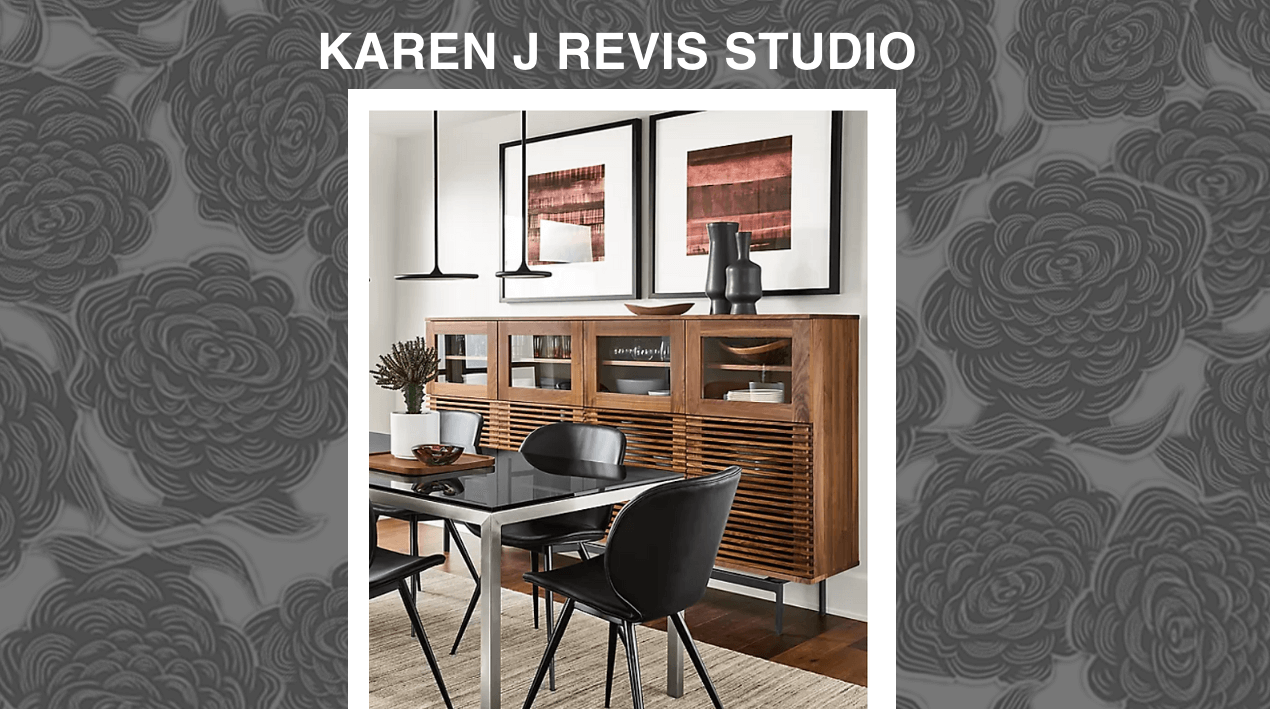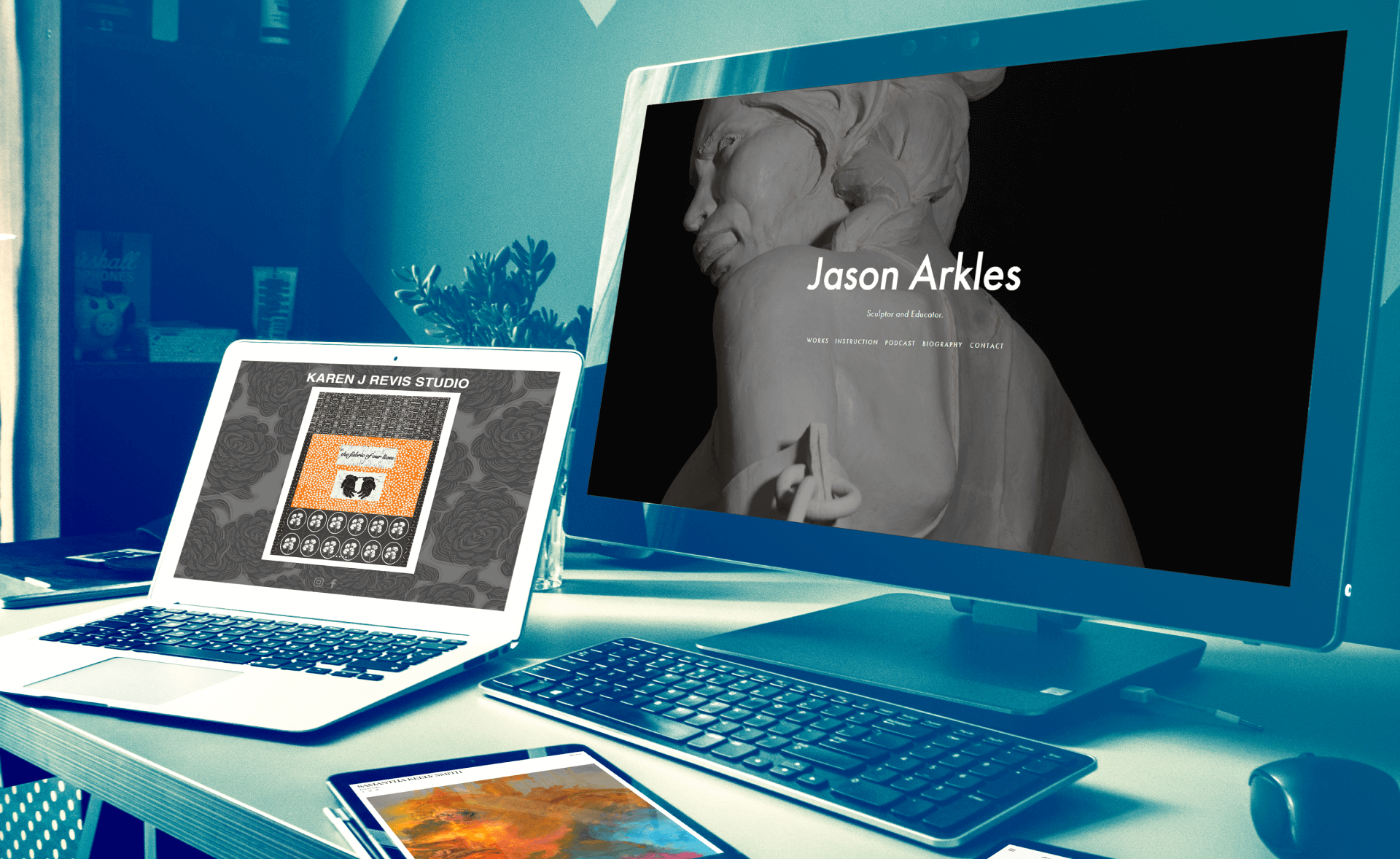Art and technology intertwine seamlessly in this digital age. For the modern visual artist, a website isn’t just a tool—it’s a digital masterpiece, reflecting your brand and showcasing your finest creations. Platforms like Squarespace, Wix, and WordPress offer bespoke templates, ensuring your site is as user-friendly as it is captivating.
Looking to sell art online? Both Shopify and Webflow are great options. Dive into top artist portfolio examples, learn how to maximize minimalist design, and let these inspirations guide you in crafting your online masterpiece with precision.
Jump here:
What Should be Seen on an Artist’s Website?
10 Artist Website Examples in 2023
- Jason Arkles
- Tinika
- Maegan Guarette
- Almost Real
- Karen J. Revis
- Benjamin Hardman
- Mel Volkman
- Samantha Keely Smith
- Sophie Kahn
- Jessica Chou
Latest Tools & Resources for Your Artist Website
What Should be Seen on an Artist’s Website?
When creating an artist website, it’s essential to strike a balance between user experience and aesthetic. One can take inspiration from some of the best artist website examples to ensure the website design is both functional and representative of the artist’s work. Here’s what you should include:
- Portfolio: An online portfolio is a must-have. It’s essentially a portfolio website that showcases your best work. Whether you’re a visual artist who specializes in watercolor or someone known for their unique doodles, your art portfolio is your identity.
- About Page: This is more than just an about page; it’s a window into your journey, inspirations, and style. This is where you share a piece of art that perhaps led you on your journey or a major event in New York or any part of the world that influenced your fine art.
- Contact Information: A contact page equipped with a user-friendly contact form provides a bridge for potential clients or collaborators to connect with you. This should be clear and easy to navigate, enhancing overall functionality.
- Testimonials/Reviews: Words of praise and feedback from past clients or art enthusiasts. This section adds credibility to your site and shows newcomers that you’re an amazing artist.
- Exhibitions/Events: Past and upcoming exhibitions, workshops, or art fairs. If you’ve participated in art galleries or events, make sure to mention that for added prestige.
- Blog/Articles: Share thoughts, techniques, or art-related stories. Blogs can improve SEO, fosters audience engagement, and showcases the artist’s expertise and process.
10 Artist Website Examples in 2023
Steer your creativity with our exclusive list of artist website examples, each crafted to perfection, blending the artist’s essence with impeccable design.
Jason Arkles

Image source: Screenshot from https://jasonarkles.com/
Jason’s artist website serves as a prime example of blending historical inspirations with contemporary design. As an adept sculptor, he masterfully incorporates 19th-century aesthetics while adding modern touches. Situated in the picturesque city of Florence, his Studio Della Statua also emphasizes the importance of location in an artist’s narrative.
The main page of his website exemplifies clarity and elegance, focusing on the artwork and key navigation links. However, there’s room for improvement on subsidiary pages, reminding designers of the importance of consistent and updated aesthetics across all site sections. This balance between old and new, simplicity and detail, offers valuable insights for artists aiming to convey their unique journey and style online.
Tinika

Image source: Screenshot from https://www.tinika-illustrations.com/
Tinneke De Block’s artist website, representing Tinika, serves as a prime example of how to effectively spotlight a niche within one’s portfolio. Emphasizing illustrations of women and their distinct features, she not only carves out a unique space for herself but also displays versatility with captivating floral and product illustrations. Aspiring artists can learn the importance of both specialization and diversification in showcasing their work, ensuring they appeal to a broad audience while also establishing a distinct identity.
Maegan Guarette

Image source: Screenshot from https://www.maeganguerette.com/
Maegan’s artist website serves as an excellent inspiration for its simplicity and clarity in showcasing her talents. As a freelance photographer and budding watercolor artist, her site effectively prioritizes her artwork, ensuring visitors immediately engage with her most prominent pieces. The intuitive navigation further facilitates user experience, categorizing her works into discernible sections.
Key takeaways from her site include the importance of a clean design, immediate focus on one’s primary work, and efficient categorization for easy user navigation. These best practices ensure a seamless and engaging viewer experience.
Almost Real

Image source: Screenshot from https://almostreal.me/
AlmostReal offers a platform to purchase exquisite art photography from a group of talented creatives. The website exudes an elegant gallery ambiance, characterized by its minimalist design and generous white spaces.
For artists aiming to sell their photographs or any art online, Almost Real sets a commendable standard with its e-commerce design.
Karen J. Revis

Image source: Screenshot from https://www.karenjrevis.com/
Karen J. Revis’s website exemplifies the power of simplicity in showcasing art. The streamlined, user-friendly design ensures her dynamic print works remain the focal point.
Aspiring artists can learn the importance of a clutter-free layout, the effective use of essential features like a gallery and biography, and the seamless integration of e-commerce to facilitate purchases. This approach emphasizes the art while ensuring a smooth user journey for potential buyers.
Benjamin Hardman

Image source: Screenshot from https://benjaminhardman.com/
Benjamin’s artist website serves as an exemplary model for those seeking to highlight their visual work. By centering his evocative photographs, especially those showcasing the intense beauty of extreme environments like Iceland, he ensures that visitors are immediately captivated. The choice of a full-screen slideshow ensures an immersive experience, while the minimalistic navigation bar ensures easy navigation without distracting from the art.
The website’s design reaffirms the principle that sometimes, less is more, allowing the artwork to shine. This approach can inspire other artists to prioritize their work and use website design elements to enhance, not overshadow, the main content.
Mel Volkman

Image source: Screenshot from https://melvolkman.com/collections/for-beauty-and-truth
Mel Volkman’s artist website is a prime example of elegant simplicity, showcasing the balance between aesthetics and functionality. Located in Maine, Mel’s site exemplifies the effective use of a clean layout to accentuate her artwork, making it a source of inspiration for budding artists. The three-column format of the ecommerce store is reminiscent of popular social media layouts, offering familiarity to visitors and facilitating ease of navigation.
Furthermore, the Journal section effectively highlights her photography skills, using a vertical sequence that allows each image to captivate viewers. From this website, readers can learn the importance of a clutter-free design, intuitive navigation, and the strategic use of familiar layouts to enhance user experience.
Samantha Keely Smith

Image source: Screenshot from https://samanthakeelysmith.com/
Samantha’s artist website, originating from Brooklyn, New York, serves as a compelling model for those looking to establish a strong digital presence. By featuring a prominent artwork on the landing page, she demonstrates the power of immediate visual engagement. Visitors are instantly introduced to the essence of her work, creating a lasting first impression. This strategy underlines the importance of showcasing key pieces to immediately captivate and connect with viewers, a best practice for artists aiming to make a memorable digital impact.
Sophie Kahn

Image source: Screenshot from https://www.sophiekahn.net/
Sophie Kahn’s artist website stands as a testament to how digital techniques can harmoniously merge with traditional art forms. Her emphasis on the human form, realized through cutting-edge 3D laser imaging, offers a unique blend of the modern and the classical.
The timeless website layout effectively highlights her best works, while the intuitive navigation ensures visitors can delve deeper into her artistic journey, exhibitions, and easily connect with her. It’s a prime example of how to seamlessly integrate content, aesthetics, and user experience for artists in the digital age.
Jessica Chou

Image source: Screenshot from https://www.jessicachouphotography.com/
Jessica Chou’s artist website serves as an exemplary model for its thoughtful design and content presentation. As a California-based photographer recognized for her documentary-style captures, she masterfully combines candidness with intimate portraits of renowned figures. What stands out is her choice of a sophisticated Squarespace template tailored for photography.
This design choice ensures her work remains the focal point, offering a clean and immersive viewing experience. Those looking to curate their portfolios can learn from Jessica’s approach: prioritizing the art while utilizing design that complements rather than competes.
Latest Tools & Resources for Your Artist Website
Navigating the digital art scene can be overwhelming, especially when it comes to crafting that perfect artist website. From web design to color palette choices, everything needs to resonate with your artistic vision. The right tools can help, and for the modern visual artist, there’s a wealth of resources at your fingertips.
Let’s start with platforms:
- Wix Art Store: Tailored just for artists, Wix allows easy uploads and sales of art online. With user-friendly interfaces, it’s perfect for those dipping their toes into the digital realm.
- Squarespace: Renowned for their minimalist design and high-quality aesthetics, Squarespace offers customizable templates ideal for any artist. Their typical white background is a canvas waiting for your piece of art.
- ArtWeb: This is more than just a platform; it’s a canvas for great artists to display their creations. Whether you’re a watercolor enthusiast or delve into graphic design, ArtWeb caters to all.
- Art Archive: Need to efficiently organize and showcase your portfolio? Art Archive is your go-to. With a simple design, your art pieces stand out, making it one of the best artist website examples.
- Adobe Portfolio: For those already invested in the Adobe suite, the integration with Creative Cloud is seamless. Easily build a site from your amazing artist creations without a hitch.
- ArtStation: Digital artists, take note. ArtStation isn’t just a platform; it’s a community. From doodles to detailed graphics, it’s the hub for the new age of digital art.
In summary
The intersection of art and technology provides an expansive platform for artists to reach wider audiences and etch their unique brand. Your website serves as a beacon, illuminating your creative journey and inviting onlookers to become a part of it.
Whether you’re just starting or are a seasoned artist, a well-crafted website can amplify your voice in the crowded art world. Reflect on your current web palette. Is it truly reflective of you? If not, perhaps it’s time for a fresh coat of digital paint. And if the task seems daunting, remember, we’re here to guide your brushstrokes.
Need expert guidance with your artist website? Get in touch with Cyphon Digital! Let us help you craft your perfect digital canvas.
